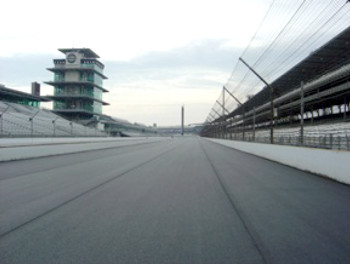Sep 10 2013
The pavement recipe for the Indianapolis Motor Speedway (IMS), home of the Indianapolis 500, could be used to improve the smoothness, durability and safety of some of the 2 million miles of paved roads and streets where people move at ordinary speeds, scientists said here today.
In reports at the 246th National Meeting & Exposition of the American Chemical Society (ACS), the world’s largest scientific society, they focused on IMS’ heritage and future potential in testing new automotive technology suitable for general transportation use. The meeting, which features almost 7,000 reports on new discoveries in science and other topics, continues here through Thursday.

“The Indianapolis Motor Speedway was built in 1909 to develop and test the latest technologies in automobiles,” noted Anthony J. Kriech, who made one of the presentations. “Many new technologies were tested under race conditions at INDY. Rearview mirrors, front-wheel and all-wheel drives, overhead cam shafts that improve engine performances, improved lubricants and oils, turbochargers, safer and more durable tires and other technology. Today IMS continues to be a leader in testing new technologies, as well as asphalt pavement development.”
IMS’ asphalt pavement was the focus of the ACS presentations by Kriech and William J. Pine, who are with Heritage Research Group, in Indianapolis, the firm that designed the asphalt now used at the speedway.
They were part of a symposium on the Chemistry of Racing and the meeting’s theme, “Chemistry in Motion.” Theme presentations showcase research and technologies likely to transform the transportation industry in the 21st century. Topics range from biofuels and alternative energy to lightweight materials and new ways of controlling the effects of friction, which impacts fuel economy
Asphalt consists of aggregates (crushed rock, sand, gravel or other material) glued together with a “binder” that usually is the thick, sticky, black bitumen formed as a product of petroleum refining or mined from natural deposits. Layered on top of compacted gravel and other material, asphalt paves about 95 percent of roads and streets in the United States.
Although most motorists never place pavement among concerns about fuel economy, road surfaces have a role in determining the cost of that next fill-up. Studies have shown, for instance, that smoother surfaces can reduce fuel consumption by about 5 percent. Roughness wastes about 555 million gallons of fuel on interstate highways annually. The surface’s stiffness and ability to resist the deflections or tiny dents made by tires is another key factor. The small dents that a vehicle makes as it rolls down the road create continuing uphill climbs that waste almost 200 million gallons of gas and diesel fuel on interstates. And interstate highways account for only 2 percent of roads in the United States.
“Road surface becomes an even more important factor when speeds exceed 220 mph, as they do at IMS,” Pine pointed out. “Imagine those speeds, hour after hour, when the sun may heat the road surface to 140 degrees Fahrenheit. It takes a road surface with a carefully calibrated combination of smoothness, durability, stability and friction.”
IMS has begun turning to asphalt for that combination after the original crushed rock surface was repaved with 3.2 million paving bricks in 1909 — origin of the track’s moniker, “The Brickyard.” Asphalt patches on rough sections of the brick led to complete resurfacing with asphalt by 1961.
Kriech described how IMS turned to chemistry to help fabricate a 21st century racing track. With the need for resurfacing on the horizon, IMS in 2004 asked Heritage Research Group to create a track surface with unparalleled smoothness, while maintaining the critical levels of friction needed to keep race cars from going airborne on turns as well as straightaways. The new surface also had to be unusually durable to resist the tearing motion of race cars zooming through turns at high speed.
Computer simulations gave the team information on the stiffness and other specifications needed for the new asphalt surface. To meet those specifications, the Heritage team worked with Firestone Polymers to develop a new asphalt binder. It was a polymer material, which would be used as an additive to bitumen and form a molecular network that reinforced the asphalt –– stiff yet highly elastic to hold up under racetrack conditions.
Heritage also did extensive studies on the aggregate for the repaving project. Their research dating from 1990 showed that a rock-like byproduct of making steel called steel slag had unique properties when used in asphalt. Steel slag gave asphalt increased strength and created the friction needed to keep cars on the road even in wet, high-speed conditions.
Kriech pointed out that Steel Slag Stone Mastic Asphalt (SMA) pavements now are used on regular roads, including interstate highways throughout Indiana and in Chicago. Steel Slag SMA pavements are especially well-suited for areas with high traffic from heavy trucks. They have greater stiffness at high temperatures, holding up better and lasting longer than conventional asphalt pavement and other advantages.
“The last resurfacing of the oval in 2004 established that the collaboration between IMS, Heritage and Firestone was a great success,” Kriech said, noting that it used an SMA formulation simulate that is in wide use in Europe for durable roads such as the autobahns in Germany. “The track will be 9 years old this autumn, and yet has the appearance of just being built. It already has exceeded the life of typical track surfaces.”
About ACS
The American Chemical Society is a nonprofit organization chartered by the U.S. Congress. With more than 163,000 members, ACS is the world’s largest scientific society and a global leader in providing access to chemistry-related research through its multiple databases, peer-reviewed journals and scientific conferences. Its main offices are in Washington, D.C., and Columbus, Ohio.